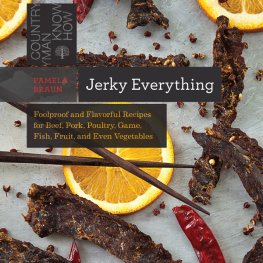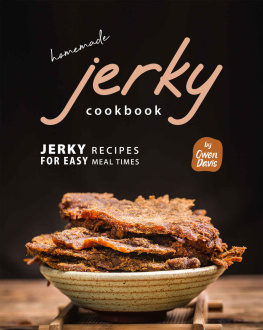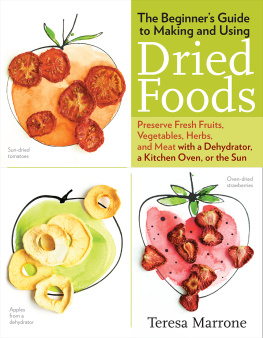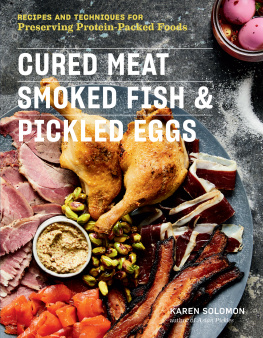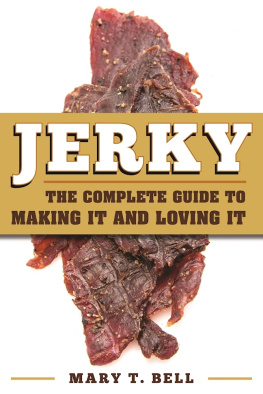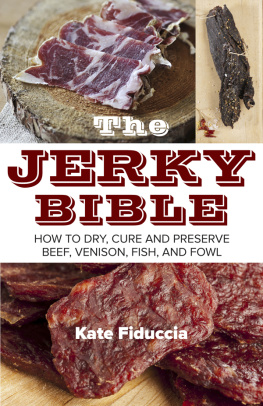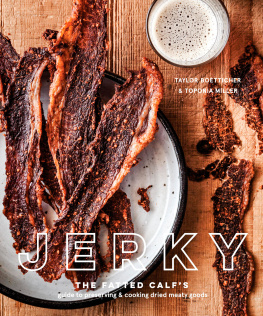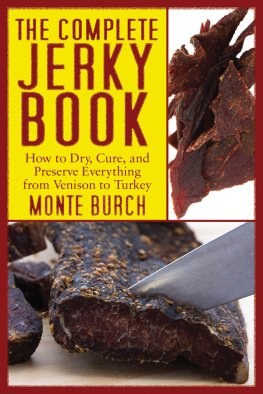

Copyright 2015 by Pamela Butkowski
All rights reserved. No part of this book may be reproduced in any form or by any electronic or mechanical means including information storage and retrieval systems without permission in writing from the publisher, except by a reviewer, who may quote brief passages.
The Countryman Press
A division of W. W. Norton & Company, Inc.
500 Fifth Avenue, New York, NY 10110
www.wwnorton.com
For information about special discounts for bulk purchases, please contact W. W. Norton Special Sales at specialsales@wwnorton.com or 800-233-4830
Jerky Everything
ISBN 978-1-58157-271-1
ISBN 978-1-58157-630-6 (e-book)
DEDICATION
For CB and RB for teaching me that simple is better and everything is easier with thumbs.

CONTENTS
If you are going to follow links, please bookmark your page before linking.
I didnt grow up in a house where jerky was around. As a teenager I tried it, once, and promptly spit it out. The hard as a rock and ridiculously chewy texture combined with some kind of flavoring that tasted like I was chewing on a solid block of Lawrys Seasoning Salt was what ended it for me. Fast-forward a few yearsokay, decadesand my love for great cuts of meat combined with my near obsession with a device called a dehydrator allowed me to realize that jerky could not only taste delicious, but is a healthy snack, and ridiculously easy and fairly inexpensive to make. Plus, its a great way to make friends. More on that later.
Ive done a great deal of traveling and have found the foods, flavors, and cooking techniques from around the world have a great influence on the cooking that I do and the recipes I create for clients and my food blog www.MyMansBelly.com. My travels have given me the opportunity to try jerky from many different cultures and countries. Things like Springbok, kudu, and plain ol beef biltong in South Africa (I really like the kudu jerky). Ive had bakkwa, or rougan, in China and Singapore. In Australia Ive eaten jerky that comes from cows, kangaroo, emu, and crocodile. And of course, Ive enjoyed lots of various flavors and types of jerky found here in the United States.
With this book, I want to take you on a culinary tour of the world through jerky. Really, this stuff isnt just something to pack away in your emergency kit, for manly men of the bush, extreme weight lifters and bodybuilders, Paleo diet martyrs, or for people who like chewing on pieces of shoe leather. Its a healthy and flavorful snack thats easy to make, easy to eat, and easy to take with you for your busy day.
Creating the recipes for this book has been an adventure. Ive met farmers and ranchers through my meat and seasonings research who have schooled me on the finer points of their respective ingredients. My recipe testers and tasters have been beyond enthusiastic. Ive got sheriffs departments, hockey teams, programmers, co-workers (my husband has made so many new friends), and neighbors that have all been a huge part of making sure that these recipes have the taste and flavors to make them a hit at your house. Oh, and if you want to make some new pals, just ask people whether theyd like to have some jerky... theyll practically hug you just for asking them.
The last time I was at the forefront of a trend, was when I picked out our new house color and then proceeded to see it popping up everywhere. Truth is, it seems that Im always a half a step behind when it comes to the cool things. Take for instance, cake balls. Theyd been out for a couple of years already when I finally decided to make them... and when I did, I shaped them into mice, not balls. Its like my subconscious isnt really sure the trend is going to stick.
Well, now its my turn to finally be cool (hey, let me have my moment). Youve probably seen, or heard, the term charcuterie being thrown around as if its some new cultish religion (for some people, it kinda is). Even though charcuterie sounds like a really fancy term (it is French after all), all it really means is the preservation of meats. Things like bacon, ham, sausage, terrines, galantines, pts, confit, and of course... jerky all fall into this category of charcuterie.
Having never really been a fan of jerky in my youth, one day I asked my husband, Craig, whether he liked the stuff. I know our dog likes it, but I really didnt think Id get much feedback on it if I made a batch and fed it all to her (although I do make her homemade chicken jerky... yes, my dog is S-P-O-I-L-E-D). Craig just kind of rolled his eyes and shrugged his shoulders, which in his world is translates to Sure, I like jerky. So I decided that I would try something new and make homemade beef jerky.
That was three years and hundreds of batches of jerky ago. If I stopped making it now, Im pretty sure my loyalty and devotion to my husband would be called into question.

Old jerky is bad, just bad. Im talking about old school jerky, the kind that our forefathers (lets face it, the men may have started it... but it was the women who actually ended up making it) gnawed on. It was created as something to help with survival as people made their way out west or went about their workday out in the fields and riding the range, so flavor wasnt really much of a must-have when the process of jerky making was undertaken.
Fast-forward to a time when dried meat wasnt a necessity to keep us alive, but more something to chew on to keep the hunger pangs at bay and to keep us from losing our mind to boredom while cruising across the country via a four-wheeled horse. Again, flavor was not of utmost importance, but the meat was expected to be at least a step above the flavor of the rubber wheels taking us to our destination.
The Egyptians took the time and effort to chisel the virtues of dried meat into stone walls, between the portraits of their beloved cats and ankhs. Seafarers pickled strips of meat, packed them in barrels, and nibbled on the strips as they crossed the vast oceans (and now you know why they were so aggressive... all that meat consumption can bind a pirate up). African folklore has herders placing strips of meat under their horses saddles to help tenderize the meat, It is said that the sweat of the horse gave the meat the flavor it needed. (If it was so good, Im wondering where that sweat spice blend is in todays supermarket.)
From seafarers to cowboys, jerky has been a source of sustenance for centuriesa simple food source created out of the necessity for explorers to eat and a way to safely preserve food in the days prior to refrigeration.
While the consumption of jerky is the same no matter where or how it is made (open mouth, insert jerky, and chew), its the making of jerky that has varied by who was making it and where it was being made.
When the Europeans arrived in the New World, they discovered Native Americans making pemmican, which consisted of ground meat mixed with fat and dried berries (usually blueberries and/or cranberries).
The Dutch had their own version of jerky, which they called tassal. Not much has been written about tassal, and its recipes, beyond the fact that it was some pretty pungent stuff and was the basis for the South African jerky known as
Next page
